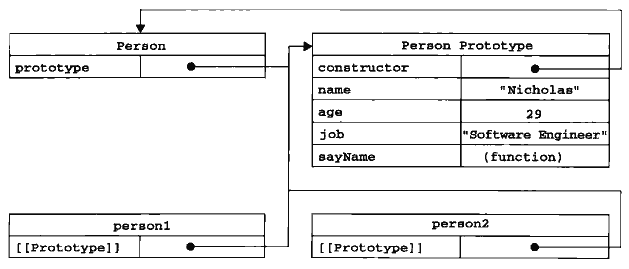js高级程序设计(第三版) 兼容bug
数组(Array)
构造函数创建数组
- new Array(arg)
arg为数字,则创建一个对应数量的数组
arg为字符串,则创建包含arg个的一个数组
new操作符可以省略
对象字面量创建数组
- bug
arr 1
2
3
4
在ie中arr的值为1,2,undefined,而在其它浏览器中arr的值为1,2
2. ```let arr = [,,,,]
在ie8以下1
2
3. ```let arr = [1,2,3,4]
若改变arr的length长度,则会改变数组对应的数据1
2
3
4
### sort 方法
sort方法默认为升序排列,但是比较的每一项的字符串,因此```let arr = [0,1,5,10,15];arr.sort();console.log(arr)//0,1,10,15,5
可以借助sort方法的参数(比较函数)得到正确的结果
1 | let arr = [0,1,5,10,15]; |
对象(Object)
对象属性类型
- 数据属性 可以直接定义
数据属性包含一个数据的位置,在这个位置可以读取和写入,数据属性有4个描述其属性的行为特性
- [[ Configureable ]] 表示能否通过delete直接删除其属性,默认值true
- [[ Enumerable ]] 表示该属性能否通过
... in ...```进行遍历,默认值为true 1
2
3
4
5
6
* * [[ Writable ]] 表示该属性的值能否修改,默认值为true
* * [[ Value ]] 表示该属性的数据值,默认值为undefined
<font color="red">以上为每个对象的属性都具有的特性,要想修改其默认属性,必须同过```Object.defineProperty()```方法</font>
- [[ Enumerable ]] 表示该属性能否通过
Object.defineProperty(属性所在的对象,属性的名字,描述符)
//描述符为以上四个属性,这样就可以修改默认值了
//例子
var person = {}
Object.defineProperty(person,”name”,{
value:”caicai”,
writable:false
})
console.log(person.name) // caicai
person.name=”hahaha”; //严格模式下报错,非严格模式下将会忽略
console.log(person.name) // caicai1
2
3
4
5
6
7
8
9
10
11
12
* 访问器属性 不可以直接定义,必须通过`Object.defineProperty()`定义
访问器属性不包含数据值,它们包含一对getter和setter函数
* * [[ Configureable ]] 表示能否通过delete直接删除其属性,默认值true
* * [[ Enumerable ]] 表示该属性能否通过```for ... in ...```进行遍历,默认值为true
* * [[ get ]] 表示读取该属性时的值,默认值为undefined
* * [[ set ]] 表示写入该属性的数据值,默认值为undefined
let book={
year:2004,
edition:1
}
Object.defineProperty(book,”year”,{
get:function(){
return this.year;
},
set:function(newValue){
if(newValue>this.year){
this.edition += newValue - this.year;
this.__year = newValue;
}
}
})
book.year = 2015;
console.log(book.edition)//121
2
3
4
5
6
7
8
9
10
### 创建对象
虽然Objectg构造函数和对象字面量都可以创建对象,但有个缺点,使用同一个接口创建很多对象,会产生大量的重复代码,因此就出现了以下的设计模式
#### * 工厂模式
用函数来封装特定的接口,然后进行创建对象
虽然解决了创建多个对象相似的问题,但是没有解决对象识别的问题
//工厂模式
funcction CreatePerson(name,age,job){
var o = new Object();
o.name = name;
o.age = age;
o.job = job;
o.sayName=function(){
return this.name
}
return o;
}
var p1 = CreatePerson(“caicai1”,20,”民工”)
var p2 = CreatePerson(“caicai2”,22,”IT民工”)1
2
3
4
5
6
7
8
9
10
11
12
13
14
15
16
17
18
19
20
21
22
23
24
25
#### * 构造函数模式
自定义构造函数,从而定义自定义对象类型的属性和方法
* * 与工厂模式的区别
* * * 1.没有显示的创建对象
* * * 2.直接将属性和方法赋值给this对象
* * * 3.没有return语句
* * 优点
* * * 1.没有显示的创建对象
* * * 2.直接将属性和方法赋值给this对象
* * * 3.没有return返回值
* * 缺点
* * * 每个方法都要在实例上重新创建一遍
* * * 可以将方法写到全局,然后赋值,这样可以解决两个函数做同一件事的问题,但是这样的话就会出现很多全局函数,没有封装可言,因此出现了原型模式
//方式一
function Person(name,age,job){
this.name = name;
this.age = age;
this.job = job;
this.sayName = function(){
return this.name
}
}
var p1 = new Person(“caicai1”,20,”民工”)
var p2 = new Person(“caicai2”,22,”IT民工”)
//方式二
function sayName(){
return this.name
}
function Person(name,age,job){
this.name = name;
this.age = age;
this.job = job;
this.sayName = sayName;
}
var p1 = new Person(“caicai1”,20,”民工”)
var p2 = new Person(“caicai2”,22,”IT民工”)1
2
3
4
5
6
#### * 原型模式
每个函数都有一个prototype属性,这个属性是个指针,指向一个对象,这个对象的用途为让所有实例的属性共享属性和方法
即为不必在构造函数中定义对象的属性和方法,而是将这些属性和方法添加到原型对象上
function Person(){}
Person.prototype.name= “caicai”
Person.prototype.age= 20
Person.prototype.job= “It”
Person.prototype.sayName= function(){
return this.name
}
var p1 = new Person();
p1.sayName()//caicai
p1.hasOwnPropertype(“name”)//false
p1.name = “hahha”
p1.hasOwnPropertype(“name”)//true
delete p1.name
p1.hasOwnPropertype(“name”)//false
var p2 = new Person();
p2.sayName()//caicai1
2
3
4
5
6
7
8
9
10

* 原型对象
只要创建函数,就会根据一组特定的规则为该函数创建一个prototype属性,而这个属性指向函数的原型对象(Function.prototype),默认情况下该原型对象会获得一个construtor属性,这个属性指向*包含一个prototype属性的函数指针*(Function.prototype.constructor),并且我们可以通过prototype对象继续添加属性和方法
<hr>
创建自定义构造函数后,其原型对象默认只会取得construtor属性,其它方法都是继承自Object
当创建一个实例后,该实例内部有一个指针(*._ _proto_ _*),指向构造函数的原型对象
function Parent(){}
var p1 = new Parent();
Parent.prototype.constructor === Parent //true
p1.proto === Parent.prototype //true1
2
3
4
5
6
7
8
确定一个属性存在于原型对象中
hasOwnProperty() //判断一个属性是否存在于实例中存在true,不存在false
in 操作符 //判断一个属性是否存在于对象中(在实例和原型上都会去寻找)
isPrototypeOf() //判断一个对象是否为构造函数的实例
function hasPrototypeProperty(object,name){
return !object.hasOwnProperty(name)&&(name in object);
}
function Person(){}
var p = new Person();
Person.prototype.isPrototypeOf(p) //true1
2
3
4
#### * 组合使用构造函数模式和原型模式
即为两种模式同时使用,构造函数用于定义实例属性,而原型模式用于定义方法和公用的属性
function Person(name,age){
this.name = name;
this.age = age;
}
Person.prototype = {
constructor:Person,
sayName:function(){
return this.name
}
}1
2
3
4
#### * 动态原型模式
因为组合模式看起来比较混乱,因此就出现动态原型模式,动态原型模式即为在构造函数内动态的创建原型对象
function Person(name,age){
this.name = name;
this.age = age;
if(typeof this.sayName!=undefined){
Person.prototype.sayName = function(){
return this.name
}
}
}
1 |
|
* 借用构造函数
在子类型的内部调用父类型的构造函数
1 | function Person() { |
* 组合继承
将借用构造函数继承和原型链继承结合在一起
1 | function Person( name ) { |